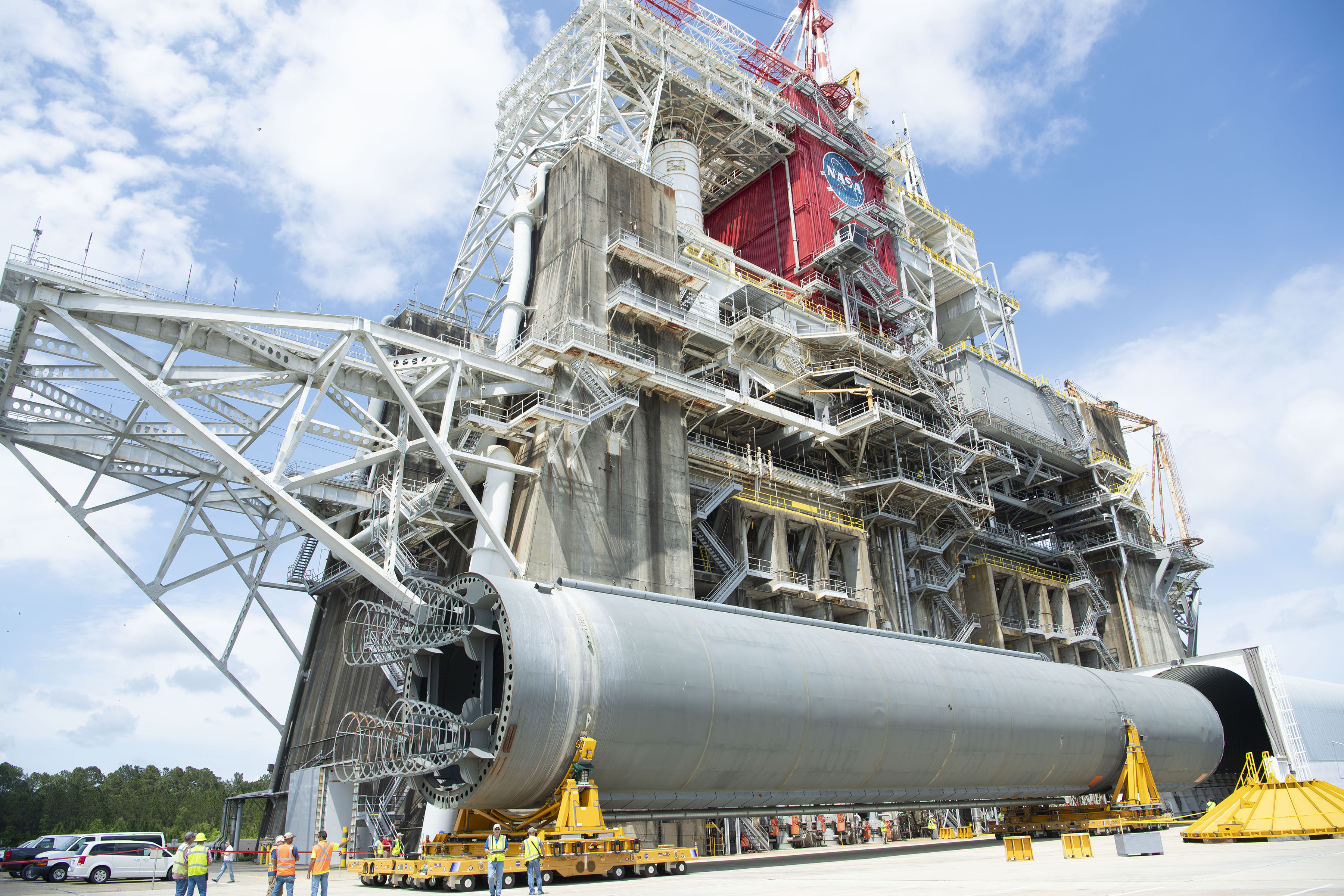
NASA will indeed perform a lengthy, involved "green run" test of its new Space Launch System (SLS) megarocket ahead of the vehicle's first flight next year, agency chief Jim Bridenstine announced today (July 25).
Bridenstine told Congress in March that NASA might skip the green run, a months-long series of tests that culminates with the firing of the SLS core stage's four RS-25 engines for 8 minutes — the duration they'll burn during a launch to the moon.
This fast-track approach could shave 6 months off the SLS' development schedule, potentially keeping the rocket on target for its debut launch in mid-2020, Bridenstine explained at the time. That uncrewed first flight, known as Artemis 1, will send NASA's Orion capsule on a trip around the moon, helping pave the way for a planned crewed landing near the lunar south pole by 2024.
Related: Photos: NASA's Space Launch System for Deep Space Flights
But today, Bridenstine announced that the SLS green run is definitely on.
"@NASA will do a Green Run test for @NASA_SLS prior to #Artemis 1. Here’s why: Astronaut safety is our #1 priority; Increases probability of a successful Moon landing in 2024; It’s important to discover issues earlier rather than later," he said via Twitter.
The green run will take place at NASA's Stennis Space Center in Mississippi. Engineers will test the 212-foot-tall (65 meters) core stage's many components during a series of checkouts and trials before finally putting everything together for the 8-minute engine firing. (The term "green run," by the way, refers to the testing and integrated operation of new hardware.)
Get the Space.com Newsletter
Breaking space news, the latest updates on rocket launches, skywatching events and more!
.@NASA will do a Green Run test for @NASA_SLS prior to #Artemis 1. Here’s why:• Astronaut safety is our #1 priority• Increases probability of a successful Moon landing in 2024• It’s important to discover issues earlier rather than laterMore: https://t.co/yTfRC4D7mq pic.twitter.com/TnTtCSGYI9July 25, 2019
"With Green Run, we verify each individual component operates well within the core stage system," SLS deputy stages manager Lisa Bates said in a statement. "It’s more than testing. It’s the first time the stage will come to life and be fully operational from the avionics in the top of the core stage to the engines at the bottom."
The SLS green run will be a first for NASA, which has historically performed such initial trials with test versions of the relevant rockets, not the actual flight hardware itself.
"Green Run is a historic moment for NASA and Stennis for a number of reasons," Stennis director Richard Gilbrech said in the same statement. "For the first time in NASA’s history, a launch vehicle will use flight hardware for its first test, and the Stennis test stands will once again test the core stage for moon missions."
If the green run goes well, engineers will check out the core stage, refurbish it as necessary and then ship it to NASA's Kennedy Space Center in Florida to await launch, NASA officials said.
Artemis is the name of NASA's ambitious lunar-exploration program, which aims to help establish a long-term, sustainable human presence on and around the moon over the course of the next decade or so. The ultimate goal is to learn the skills and strategies necessary to get astronauts safely to Mars, NASA officials have said.
The first Orion-SLS flight to carry astronauts, Artemis 2, is scheduled to lift off no earlier than 2022.
- NASA's 1st Orion Spacecraft Test Flight in Photos
- NASA Test-Fires Megarocket Engine That May Take Astronauts to the Moon (Video)
- Apollo 11 at 50: A Complete Guide to the Historic Moon Landing Mission
Mike Wall's book about the search for alien life, "Out There" (Grand Central Publishing, 2018; illustrated by Karl Tate), is out now. Follow him on Twitter @michaeldwall. Follow us on Twitter @Spacedotcom or Facebook.
Join our Space Forums to keep talking space on the latest missions, night sky and more! And if you have a news tip, correction or comment, let us know at: community@space.com.

Michael Wall is a Senior Space Writer with Space.com and joined the team in 2010. He primarily covers exoplanets, spaceflight and military space, but has been known to dabble in the space art beat. His book about the search for alien life, "Out There," was published on Nov. 13, 2018. Before becoming a science writer, Michael worked as a herpetologist and wildlife biologist. He has a Ph.D. in evolutionary biology from the University of Sydney, Australia, a bachelor's degree from the University of Arizona, and a graduate certificate in science writing from the University of California, Santa Cruz. To find out what his latest project is, you can follow Michael on Twitter.









